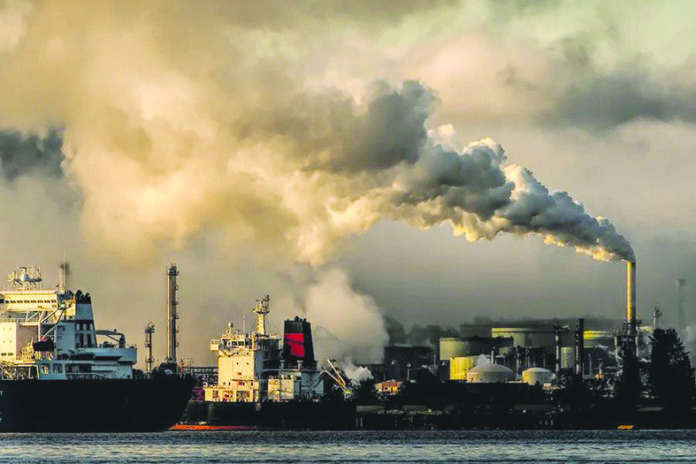Thermal pollution refers to the degradation of water quality by any process that changes ambient water temperature. A common cause of thermal pollution is the use of water as a coolant by power plants and industrial manufacturers.
When water used as a coolant is returned to the natural environment at a higher temperature, the sudden change in temperature decreases oxygen supply and affects ecosystem composition. Aquatic organisms, particularly fish, amphibians, and other wildlife, can be sensitive to changes in temperature, which can lead to harmful effects such as decreased fertility, reduced growth rates, and increased susceptibility to diseases.
Another source of thermal pollution is the runoff from paved surfaces and urban areas, which can be significantly warmer than nearby water bodies. This type of thermal pollution can lead to similar ecological disturbances, as it also raises the temperature of water bodies.
Thermal pollution can have several negative effects on aquatic environments, including:
- ALTERED OXYGEN LEVELS: Warmer water holds less dissolved oxygen, which aquatic life relies on.
- DISRUPTION OF BREEDING CYCLES: Some species have breeding cycles that are triggered by temperature changes, which can be disrupted by sudden changes in water temperature.
- CHANGES IN SPECIES COMPOSITION: Some species may be unable to survive the warmer temperatures, leading to changes in the ecosystem’s species composition and potentially to the loss of biodiversity.
- INCREASED VULNERABILITY TO POLLUTANTS: Warmer temperatures can increase the toxicity of certain pollutants in the water, making aquatic life more susceptible to them. Mitigating thermal pollution often involves improving industrial cooling processes, such as using cooling towers to dissipate heat to the atmosphere instead of directly to water bodies, or implementing more efficient water recycling systems to reduce the amount of warm water discharged.
The history of thermal pollution is closely tied to the Industrial Revolution and the subsequent increase in industrial activities that required large amounts of cooling water. As industries grew, especially during the 19th and 20th centuries, the need for cooling processes in manufacturing, power generation, and other industrial operations led to the widespread use of natural water bodies for this purpose. The discharge of heated water back into rivers, lakes, and oceans became a common practice, leading to the phenomenon of thermal pollution.
CAUSES OF THERMAL POLLUTION:
- POWER PLANTS AND INDUSTRIAL COOLING: The primary cause of thermal pollution is the use of water as a cooling medium by power plants and industrial facilities. These plants often draw water from nearby sources, use it to absorb heat from machinery or processes, and then discharge the heated water back into the environment. Nuclear and fossil fuel power plants are significant contributors to thermal pollution due to their extensive cooling requirements.
- DEFORESTATION: The removal of vegetation cover can also lead to thermal pollution in nearby water bodies. Vegetation provides shade and helps to maintain lower water temperatures. Its removal results in direct sunlight heating up the water more than usual, thus increasing its temperature.
- URBAN RUNOFF: Heated water from paved surfaces, buildings, and other urban infrastructure can enter water bodies during rainfall, leading to increased temperatures. This is particularly evident in densely populated or heavily developed urban areas.
- SOIL EROSION: Soil erosion can lead to shallower water bodies, which heat up more quickly than deeper ones. The removal of soil and vegetation can exacerbate this effect, leading to higher water temperatures.
- WATER WITHDRAWAL: The withdrawal of water for irrigation, industrial, and domestic use can reduce water flow in rivers and streams, making them more susceptible to heating by the sun.
However, the awareness and regulation of thermal pollution are relatively recent developments. It wasn’t until the environmental movements of the 1960s and 1970s that significant attention was given to the impacts of industrial discharges on ecosystems, including thermal pollution.
Environmental Monitoring and Assessment: Regular monitoring of water temperatures and aquatic ecosystems can help identify sources of thermal pollution and assess the effectiveness of mitigation measures to reduce the impact of thermal pollution on aquatic ecosystems and maintain healthier, more balanced water environments.
The USA, for example, addressed thermal pollution explicitly in the Clean Water Act of 1972, which set the framework for regulating pollutant discharges into the waters of the USA, including thermal discharges. Globally, environmental regulations have increasingly recognized the need to address thermal pollution, with various countries implementing policies and guidelines to mitigate its effects. These include requiring industries to adopt cooling technologies that minimize temperature changes in discharged water, such as cooling ponds, towers, and closed-cycle cooling systems, which reuse water for cooling purposes.
Thermal pollution has several negative effects on the various systems and subsystems of the environment which include:
- ECOSYSTEM DISRUPTION: Sudden changes in water temperature can disrupt local ecosystems, harming or killing fish and other aquatic organisms that are not adapted to the higher temperatures.
- DECREASED OXYGEN LEVELS: Warmer water holds less oxygen, which can lead to oxygen depletion, affecting aquatic life that relies on high oxygen levels.
- ALTERED SPECIES COMPOSITION: Some species may thrive in warmer temperatures, outcompeting and displacing native species, leading to reduced biodiversity.
- INCREASED TOXICITY: Higher temperatures can increase the toxicity of certain chemicals and pollutants in the water, making them more harmful to aquatic life.
- HARMFUL ALGAL BLOOMS: Warm water can encourage the growth of harmful algae, which can deplete oxygen levels further and release toxins that affect aquatic and human health.
- REPRODUCTIVE ISSUES: Thermal pollution can disrupt the reproductive cycles of aquatic species, leading to decreased populations over time.
PREVENTION AND MITIGATION OF THERMAL POLLUTION:
- COOLING TOWERS: These structures transfer waste heat to the atmosphere through evaporation and convection, rather than discharging hot water into natural water bodies.
- COOLING PONDS: Large, shallow ponds allow heated water to cool as it moves through the pond before being released back into the environment.
- CLOSED-CYCLE SYSTEMS: These systems reuse cooling water, rather than taking in fresh water from natural sources, significantly reducing thermal discharge.
- COGENERATION: This process involves using waste heat from industrial processes for other purposes, such as heating buildings or generating electricity, thereby reducing the amount of heat discharged into water bodies.
- SUSTAINABLE URBAN PLANNING: Incorporating green spaces, vegetation, and permeable surfaces in urban areas can reduce surface runoff and help maintain natural water temperatures.
- REGULATORY MEASURES: Implementing and enforcing regulations that limit temperature increases in natural water bodies can help control thermal pollution. This can include setting maximum temperature differentials for discharged water and requiring the use of specific cooling technologies.
- THERMAL EFFLUENT LIMITATIONS: Setting strict limits on the temperature and volume of effluents discharged from industrial and power generating facilities can help minimize thermal pollution.
- ENVIRONMENTAL MONITORING AND ASSESSMENT: Regular monitoring of water temperatures and aquatic ecosystems can help identify sources of thermal pollution and assess the effectiveness of mitigation measures to reduce the impact of thermal pollution on aquatic ecosystems and maintain healthier, more balanced water environments.























